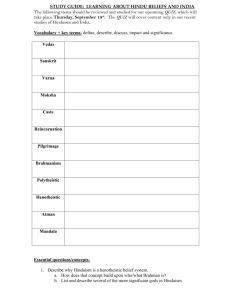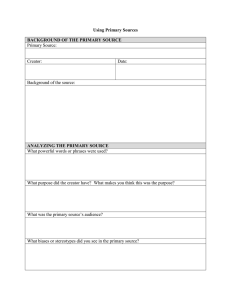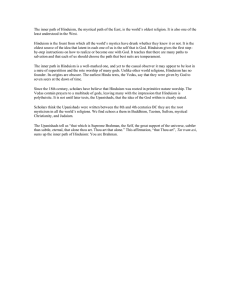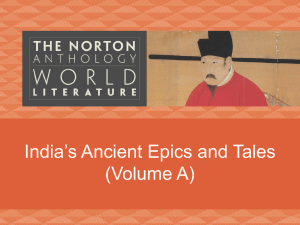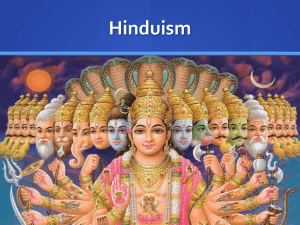Neo-Hinduism, Vedas, and The Supreme
advertisement
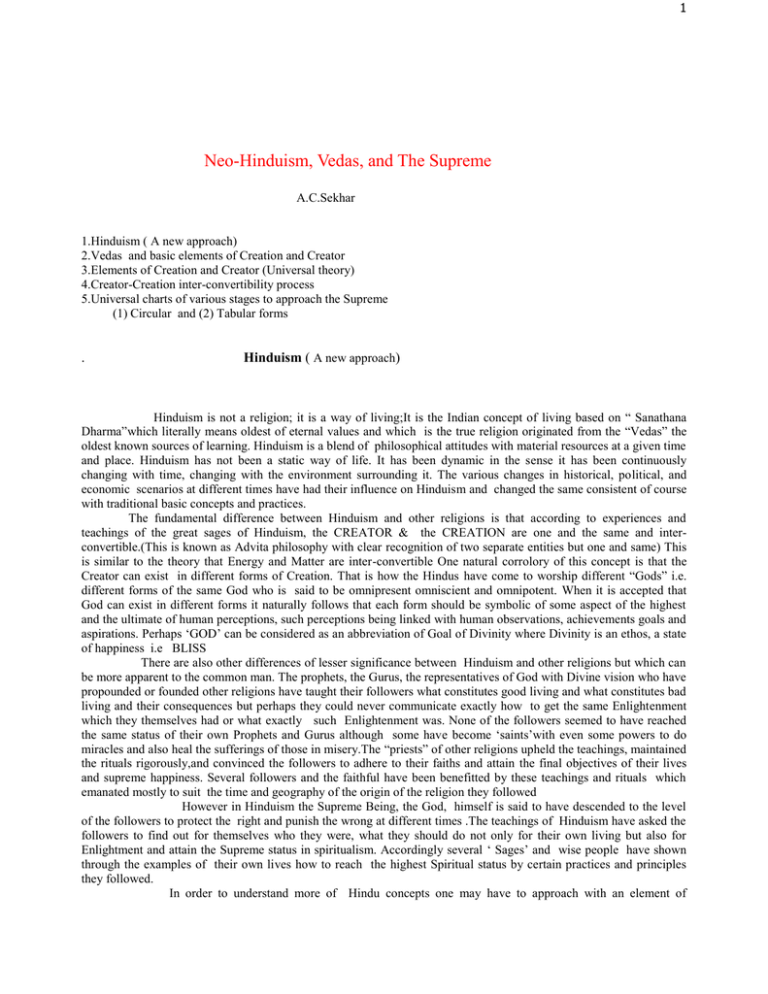
1 Neo-Hinduism, Vedas, and The Supreme A.C.Sekhar 1.Hinduism ( A new approach) 2.Vedas and basic elements of Creation and Creator 3.Elements of Creation and Creator (Universal theory) 4.Creator-Creation inter-convertibility process 5.Universal charts of various stages to approach the Supreme (1) Circular and (2) Tabular forms . Hinduism ( A new approach) Hinduism is not a religion; it is a way of living;It is the Indian concept of living based on “ Sanathana Dharma”which literally means oldest of eternal values and which is the true religion originated from the “Vedas” the oldest known sources of learning. Hinduism is a blend of philosophical attitudes with material resources at a given time and place. Hinduism has not been a static way of life. It has been dynamic in the sense it has been continuously changing with time, changing with the environment surrounding it. The various changes in historical, political, and economic scenarios at different times have had their influence on Hinduism and changed the same consistent of course with traditional basic concepts and practices. The fundamental difference between Hinduism and other religions is that according to experiences and teachings of the great sages of Hinduism, the CREATOR & the CREATION are one and the same and interconvertible.(This is known as Advita philosophy with clear recognition of two separate entities but one and same) This is similar to the theory that Energy and Matter are inter-convertible One natural corrolory of this concept is that the Creator can exist in different forms of Creation. That is how the Hindus have come to worship different “Gods” i.e. different forms of the same God who is said to be omnipresent omniscient and omnipotent. When it is accepted that God can exist in different forms it naturally follows that each form should be symbolic of some aspect of the highest and the ultimate of human perceptions, such perceptions being linked with human observations, achievements goals and aspirations. Perhaps ‘GOD’ can be considered as an abbreviation of Goal of Divinity where Divinity is an ethos, a state of happiness i.e BLISS There are also other differences of lesser significance between Hinduism and other religions but which can be more apparent to the common man. The prophets, the Gurus, the representatives of God with Divine vision who have propounded or founded other religions have taught their followers what constitutes good living and what constitutes bad living and their consequences but perhaps they could never communicate exactly how to get the same Enlightenment which they themselves had or what exactly such Enlightenment was. None of the followers seemed to have reached the same status of their own Prophets and Gurus although some have become ‘saints’with even some powers to do miracles and also heal the sufferings of those in misery.The “priests” of other religions upheld the teachings, maintained the rituals rigorously,and convinced the followers to adhere to their faiths and attain the final objectives of their lives and supreme happiness. Several followers and the faithful have been benefitted by these teachings and rituals which emanated mostly to suit the time and geography of the origin of the religion they followed However in Hinduism the Supreme Being, the God, himself is said to have descended to the level of the followers to protect the right and punish the wrong at different times .The teachings of Hinduism have asked the followers to find out for themselves who they were, what they should do not only for their own living but also for Enlightment and attain the Supreme status in spiritualism. Accordingly several ‘ Sages’ and wise people have shown through the examples of their own lives how to reach the highest Spiritual status by certain practices and principles they followed. In order to understand more of Hindu concepts one may have to approach with an element of 2 scientific outlook. The entire Creation may be considered as consisting of the following five basic elements: Matter: The physical content (in different states) Energy : The power generating capacity (in different forms) Space: The volume limitation (indifferent directions) Time: The assigned window between birth & death of creation with infinete limits Cosmos : The all pervading medium responsible for cause and effect ; The medium through which transformation takes place between individual Self and Universal Self., a concept which arouses the consciousness of the unity of all life, which is peculiar to Hinduism . This is also the so called MAYA power Each of these elements can be further divided into sub-groups which requires further analytical discussion. However all parts of Creation should be viewed from three different visions or view points. Divik: from Divine & Spiritual point of view Bhoutik: from earthly or physical point of view Adhyatmic: from sub-conscious or imaginary point of view. If one looks at any object, sees anything, hears anything, feels anything by touch, smells anything, or even speaks anything, anything done by any of the five physical senses of human body one should try to view the same from the three view points mentioned above; one has to think over the origin, the cause and effects of the same. In the sequential logic that arises from such thinking and such thoughts, one would be able to find the relationship between the Creator and the created as sensed by any of the physical senses and which is the basic philosophy conceived , experienced, and practiced even unknowingly, in the Indian way of life ie Hinduism. There are many common beliefs practices in Hinduism, which are sometimes dubbed as superstitions or blind faith practices but which do have some scientific reasoning based on the knowledge of the day ie of the period of development of Hindu civilization. Some of these are: (1)Idol worship: different gods in different shapes of idols representing different aspects of human life. spiritual concepts arising from the same; Development of religious literature( Epics & Puranas.) (2) Rituals: Performed during festivities, social functions, marriages, funerals etc. (3) General concepts: Birth, Death, Salvation Auspicious and inauspicious times and actions, theory of re-incarnation. etc. (4) Life styles: Food, clothing, housing,; work culture , caste system , social courtesies (5)Governance: Politics, Economics and Administration These require to be discussed in greater detail , but in a general way at this point two factors may emerge if the above beliefs and practices are analyzed and viewed from the three different view points mentioned above (1) the relationship between what has been created and what has created them and (2)the inter - relationship between materialistic developments and spiritualism .. Traditional beliefs, and also several literary works of Hinduism, the legendary as well as modern, indicated the existence of three types of beings. (1) Super- human or Devthas, (2)Ordinary human or Manavas(3) Sub-human or Rakshasas.The first are associated with constant shape of the body with no aging or death and very powerful transcendental minds . Some of these are associated with manipulating and controlling forces of Nature like winds, tides, fire etc. The second are associated with almost equal powers of body and mind which grow and develop with age and time but ultimately meet decay and death. They can under certain circumstances, develop capabilities of either achieving highest goals of life or fall into most downtrodden situations.The third have powerful and transcendental bodies generally craving for eternal life with no death but always failed to achieve the same inspite of special boons from their Gods. They have evil powers of the mind, with almost single track only. The ordinary human beings are sometimes wittingly characterized as the one above them or as one below depending on their activities and circumstantial behavior patterns. In the Hindu literature there are many what are called ‘Puranas’ which are fabled stories,which have brought out interaction between different types of beings and which have guided the minds of people for following their own life styles and good living. There are also Epics and poems like Ramayana and Mahabharata which have permanent imprint in the minds of people for discriminating the righteous from the wrong.But basically Hinduism as mentioned above is founded on Vedas which are four in number (1)Rig Veda (2)Yajur Veda and(3) Sama Veda (4)Atharvana Veda all of which contain not only hymns in praise of Nature and God, methods of rituals for meditation, worship and duties of life, but they also contain material to realise the Ultimate Truth through a series of discussions and elimination of common doubts. These are contained in what are called Upanishads which are the last parts of each Veda, also called Vedanta. However all these legendary literature leads to one and only one main thought to seek through oneself and realise the Ultimate which is called Brahman . Rig Veda says ‘Pragnanam Brahma’ which means Consciousness is Brahman; Yajur Veda says ‘Aham Brahmasmi’ which means the ‘ I ‘ in oneself is Brahman ; Sama 3 Veda says ‘Tatvamasi’ which means That thou art and finally the Atharvana Veda says ‘Ayamatma’ which means the Self is Brahman. Thus it is made clear in all of the Hindu literature that the Truth is one but the paths to find the same may be many. This is the central theme of entire Hinduism for a man to live happily with full understanding of his surroundings and achieve the Goal of his life. . Vedas and basic elements of Creation and Creator The Vedas are considered as the oldest source of religious knowledge The exact period when they written and the author(s) are not known but their study is said to have revealed the truth of Creator and Creation in philosophical discourses virtually the same knowledge which modern Science has brought out experimentally and theoretically. The classification, distribution of Vedas, and the elements of Creation and Creator are indicated below VEDAS ! ___________ _________________________________________________________________ ! ! ! ! Rig Veda Yajur Veda Sama Veda Atharvana Veda Around 750 A.D. after establishing four centers of transcendentalwisdom, Adi Sankara alloted different Vedas to the different centersThere are also other smaller centers that came up later. But essentially all Vedas at all centers teach the same in the end ! ! ! ! At Jagannath Puri At Sringeri At Dwaraka At Joshimutt East India South India West India North India Pragnanam Brahma Aham Brahmasmi Tat Twam Asi Ayamatma Consciousness is Brahma ‘ I’ is Brahma That Thou Art ‘ Self ‘ is Brahma in in in in Aitereya Brihadaranya Chandyogya Manduka Upanishad Upanishad Upanishad Upanishad Each Veda consists of four parts as follows: 1. Manthras: Lyrical poems on nature and power of the forces for the Man to first see, observe and enjoy in the world mainly during boyhood 2. Brahmanas:Rituals of various ceremonies which a Man should perform particularly during his married life which is his mid-life 3. Aranyakas: Methods of Meditation; Upasanas to be performed by Men during their last stages of life 4. Upanishads: Also known as Vedantas, i.e. the ends of Vedas. These are essentially discourses between a teacher (supposed to be the Lord himself) and a mature Student (who is supposed to have good knowledge of the world and worldly experiences ) The discussions mainly surround the purpose of Creation and goals of human existence. So far about 280 Upanishads are said to have been unearthed of which about 180 have been commented upon by great sages. Of these there are eleven called Major Upanishads and commented upon by Master Minds like Sankara, Ramanuja, Madvacharya and written as Bhashyas. 4 Elements of Creation and Creator (Universal Theory) Elements of Creation: (Three categories) 1.Matter: Solids, Liquids, Gas 2. Energy :Potential, Kinetic ______ ! !______ ! ! 1 ! ____ ! Physical category measurable from a fixed zero to a finite value _______ 3. Time : Past, Present and Future ! ! Trancendental category ! _______ No fixed origin. Varies ! from minus infinity to ! plus infinity 4.Space: Limited within measurable ! boundaries an ! unlimited without ! boundaries ! _______ ! _______ 5.Cosmos: (Maya) All pervading medium ! through which !_________ Spiritual Category transformations take place ! ______! Elements of Creator (The Powers relating to Creation (Abstract but personified ) Brahma : Activates Creation by the help of Knowledge personified in Saraswati Vishnu: Preserves the Creation by the help of Wealth personified in Lakshmi Iswar: Self: Modifies the Creation by the help of Super Power personified in Parvathi The inherent sustaining unit which keeps up the dynamic activity of creation (Jeevatma, Paramatma) Destiny: The pre-determined end of a particular creation, before it is altered; unknown until it is altered 5 Creator-Creation Interconvertibility process CREATOR ____________________!__________________ ! ! Path of Phillosophy Path of Science and Religion and observation Discussions between Theory and Experimentation Teacher and Student through (Vedic style) (Modern Science and Technology) ! Experience Moksha and Bliss ! Realise Truth and the Ultimate of CREATION Consisting of (Basic elements:Time, Space, Energy, Matter, & Cosmos-Maya) ____________________!___________________ ! ! A combination of these can explain View these from the points of view of 1.The theory of interconvertibility Divika: Supernatural and Spiritual of creator and creation Bhoutika: Natural and Physical 2. All that has been taught by Religion Adhyatmica: Subnatural, mental 3.All that has been taught by sciences ! 4.All that has been taught by philosophy ! !_________________________________________________! ! understand CREATOR, the Power Thus what has been created once cannot remain permanent or eternal in nature. It has to end at sometime or other and go back to creator The power of preserving creation as symbolized by Vishnu is however indicated in Hindu mythology as existing in ten different stages , popularly known as Dasavataras or ten incarnations of Vishnu One aspect of these Avataras is that they represent physical evolution of life forms and spiritual stages of development to reach the Supreme Creator. Given below is the physical part 1. Matsya- First life started under water 2. Kurma- This is the stage when life existed both under water and land 3. Varaha-Life was freely existing on land itself 4. Nrusimha-Half man and half beast stage of existence 5.Vamana-entirely man with developing powers 6. Parashurama- Man with uncontrolled emotions 7. Sree Rama-Ideal man( ideal son, ideal husband, ideal king,) 8 Sree Krishna-Supreme source of knowledge and perfect joy 9 Buddha- Enlightenment 10. Kalki- Ruthless striker of developing evil (Yet to come) 6 Universal Chart of Various stages to reach the Supreme (Circular and tabular forms) The Creation consists of basic five elements, matter ,energy ,time. space and cosmos but there are several factors involved in combination of these and several stages to reach the Supreme. Many of these cannot be described in exact and absolute terms of evaluation. This is a kind of MAYA or illusion in a sense. However to accept that permanency exists, that there is something ETERNAL even when not the same permanency exists. i,e, when illusion exists then some form of dynamic activity continuously passing from one stage to another is needed, and so the theory of interconvertability of Creator and Creation, incarnation and reincarnation, conversion of one form into another, of matter into energy and vice-versa, becomes acceptable and workable. The state of art of human existence and in fact the existence of all Creation in different stages can be indicated by three concentric circular spaces divided into eight segments around the Supreme which is in the centre of all Creation represented by OM ALLAH ALMIGHTY etc.. Some physical and spiritual interactions are needed for any part of creation and in fact for all human beings to reach the Supreme and such interaction on the same stage . Owing to some problems of drawing the circular forms the same is not drawn here but the same is indicated in a tabular form for convenience of easy follow up. Entity Stage 1 Stage 2 Stage 3 ULTIMATE 1 Child-Youth Middle age Old age ______________________________________________________________ AU M 2 Objective Subjective Contemplative _____________________________________________________________ 3 Body Mind Intellect Wordly issues Personal issues Cosmic issues ___________________________________________________________________ ALLAH 4 Physical feelings Personal thoughts Intellectual Realisation Sensual experiences Analytical mind Trancendental Knowledge of World of activities external world introspection ______________________________________________________________________ ALMIGHTY 5 Any fixed level Ones own level No fixed level Solid state Liquid state Gaseous state Immoveable by Process of flow All pervading itself in one direction sublime ______________________________________________________________________ AKASH,_ 6 Emotional Feeler Realisation of Wordly observations Analytical mind Truth _____________________________________________________________________ __ AKAL 7 External World Own Voice Inner Voice Heard not spoken Spoken outwordly Spoken inwordly _____________________________________________________________________ 8 Arbitrary origin Finite measurable Infinite All begin with of space & time space & Time Space & Time first letter vaguely measured with respect to a ‘ A’ and connected recognized origin specifically chosen 7 , 8
